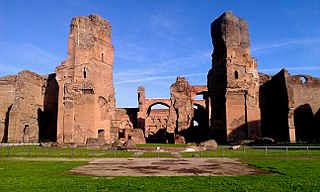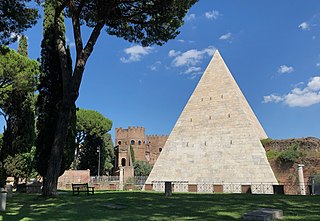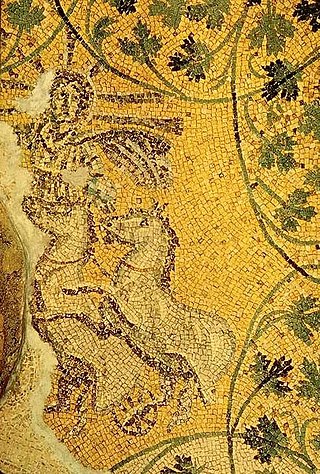
The Catacombs of Rome are ancient catacombs, underground burial places in and around Rome, of which there are at least forty, some rediscovered only in recent decades. Though most famous for Christian burials, either in separate catacombs or mixed together, Jews and also adherents of a variety of pagan Roman religions were buried in catacombs, beginning in the 2nd century AD, occasioned by the ancient Roman ban on burials within a city, and also as a response to overcrowding and shortage of land. The most extensive and perhaps the best known is the Christian Catacomb of Callixtus located near the Park of the Caffarella, but there are other sites, both Christian and not, scattered around the city, some of which are now engulfed by modern urban sprawl.

The Papal Basilica of Saint Paul Outside the Walls is one of Rome's four major papal basilicas, along with the basilicas of Saint John in the Lateran, Saint Peter's, and Saint Mary Major, as well as one of the Seven Pilgrim Churches of Rome.

The Vatican Museums are the public museums of Vatican City. They display works from the immense collection amassed by the Catholic Church and the papacy throughout the centuries, including several of the most well-known Roman sculptures and most important masterpieces of Renaissance art in the world. The museums contain roughly 70,000 works, of which 20,000 are on display, and currently employ 640 people who work in 40 different administrative, scholarly, and restoration departments.

The Baths of Caracalla in Rome, Italy, were the city's second largest Roman public baths, or thermae, after the Baths of Diocletian. The baths were likely built between AD 212 and 216/217, during the reigns of emperors Septimius Severus and Caracalla. They were in operation until the 530s and then fell into disuse and ruin.

The pyramid of Cestius is a Roman Era pyramid in Rome, Italy, near the Porta San Paolo and the Protestant Cemetery. It was built as a tomb for Gaius Cestius, a member of the Epulones religious corporation. It stands at a fork between two ancient roads, the Via Ostiensis and another road that ran west to the Tiber along the approximate line of the modern Via Marmorata. Due to its incorporation into the city's fortifications, it is today one of the best-preserved ancient buildings in Rome.

Saint Peter's tomb is a site under St. Peter's Basilica that includes several graves and a structure said by Vatican authorities to have been built to memorialize the location of Saint Peter's grave. St. Peter's tomb is alleged near the west end of a complex of mausoleums, the Vatican Necropolis, that date between about AD 130 and AD 300. The complex was partially torn down and filled with earth to provide a foundation for the building of the first St. Peter's Basilica during the reign of Constantine I in about AD 330. Though many bones have been found at the site of the 2nd-century shrine, as the result of two campaigns of archaeological excavation, Pope Pius XII stated in December 1950 that none could be confirmed to be Saint Peter's with absolute certainty. Following the discovery of bones that had been transferred from a second tomb under the monument, on June 26, 1968, Pope Paul VI said that the relics of Saint Peter had been identified in a manner considered convincing. Only circumstantial evidence was provided to support the claim.

Cerveteri is a town and comune of northern Lazio in the region of the Metropolitan City of Rome. Known by the ancient Romans as Caere, and previously by the Etruscans as Caisra or Cisra, and as Agylla by the Greeks, its modern name derives from Caere Vetus used in the 13th century to distinguish it from Caere Novum.

Teano is a town and comune in the province of Caserta, Campania, southern Italy, 30 kilometres (19 mi) northwest of Caserta on the main line to Rome from Naples. It stands at the southeast foot of an extinct volcano, Rocca Monfina. Its St. Clement's cathedral is the see of the Roman Catholic Diocese of Teano-Calvi, which started as the Diocese of Teano circa AD 300.

The study of Roman sculpture is complicated by its relation to Greek sculpture. Many examples of even the most famous Greek sculptures, such as the Apollo Belvedere and Barberini Faun, are known only from Roman Imperial or Hellenistic "copies". At one time, this imitation was taken by art historians as indicating a narrowness of the Roman artistic imagination, but, in the late 20th century, Roman art began to be reevaluated on its own terms: some impressions of the nature of Greek sculpture may in fact be based on Roman artistry.

The National Roman Museum is a museum, with several branches in separate buildings throughout the city of Rome, Italy. It shows exhibits from the pre- and early history of Rome, with a focus on archaeological findings from the period of Ancient Rome.

The Basilica of Saints John and Paul on the Caelian Hill is an ancient basilica church in Rome, located on the Caelian Hill. It was originally built in 398.

Valmontone is a comune (municipality) in the Metropolitan City of Rome in the Italian region Lazio, located about 45 kilometres southeast of Rome.

The Caffarella Park is a large park in Rome, Italy, protected from development. It is part of the Parco Regionale Appia Antica. The park is contained in the Caffarella Valley and is bordered on its northern side by the Via Latina and on its southern by the Appian Way. It stretches from the main Rome-Pisa railroad tracks near the Aurelian Wall at its western edge to the Via dell'Almone to the east. It contains several sites of archaeological interest, as well as a working farm, and has considerable ecological value, with 78 species of birds and fauna. The Catacombs of Rome and Colli Albani are nearby.

The Tomb of the Scipios, also called the hypogaeum Scipionum, was the common tomb of the patrician Scipio family during the Roman Republic for interments between the early 3rd century BC and the early 1st century AD. Then it was abandoned and within a few hundred years its location was lost.

The Vatican Necropolis lies under the Vatican City, at depths varying between 5–12 metres below Saint Peter's Basilica. The Vatican sponsored archaeological excavations under Saint Peter's in the years 1940–1949 which revealed parts of a necropolis dating to Imperial times. The work was undertaken at the request of Pope Pius XI who wished to be buried as close as possible to Peter the Apostle. It is also home to the Tomb of the Julii, which has been dated to the third or fourth century. The necropolis was not originally one of the Catacombs of Rome, but an open-air cemetery with tombs and mausolea.

The Catacomb(s) of Callixtus is one of the Catacombs of Rome on the Appian Way, most notable for containing the Crypt of the Popes, which once contained the tombs of several popes from the 2nd to 4th centuries.

The Teutonic Cemetery is a burial site in Rome adjacent to St. Peter's Basilica. Burial is reserved for members of the Confraternity of Our Lady of the German Cemetery, which owns the cemetery. It is a place of pilgrimage for many German-speaking pilgrims.

The Appian Way Regional Park is the second-largest urban park of Europe, after Losiny Ostrov National Park in Moscow. It is a protected area of around 4580 hectares, established by the Italian region of Latium. It falls primarily within the territory of Rome but parts also extend into the neighbouring towns of Ciampino and Marino.

Crepereia Tryphaena was a young Roman woman, presumably about 20 years old, whose sarcophagus was found during the excavation works started in 1889 for the foundations of the Palace of Justice and for the construction of the Umberto I bridge over the Tiber in Rome. Among the items found in her sarcophagus were pieces of a funeral outfit, including a sculpted doll.

The Tomb of the Haterii is an Ancient Roman funerary monument, constructed between c. 100 and c. 120 CE along the Via Labicana to the south-east of Rome. It was discovered in 1848 and is particularly noted for the numerous artworks, particularly reliefs, found within.





















